
- •Explanation
- •1. Flash (the default location) 2. Tftp server 3. Rom (used if no other source is found)
- •Question 3
- •In a switched environment, what does the ieee 802.1q standard describe?
- •Question 8
- •Question 3
- •Vlan 3 is not yet configured on your switch. What happens if you set the switchport access vlan 3 command interface configuration mode?
- •Explanation
- •In the Frame Relay network, which ip addresses whould be assigned to the interfaces with point-to-point pvCs?
- •It has become necessary to configure an existing serial interface to accept a second Frame Relay virtual circuit. Which of the following are required to solve this? (Choose three)
- •If ip routing is enabled, which two commands set the gateway of last resort to the default gateway? (Choose two)
- •Question 8
- •Explanation
- •Explanation
- •If the startup-config file is missing or does not specify a location, it will check the following locations for the ios image:
- •Question 4
- •Explanation
- •Explanation
Question 4
Refer to the exhibit:
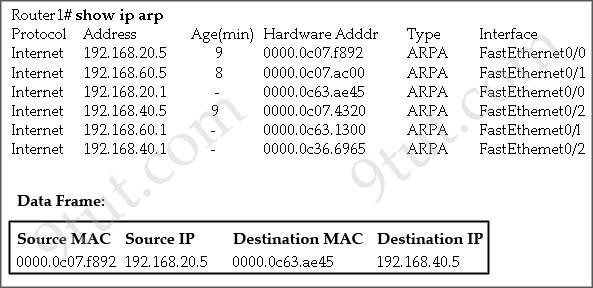
What will Router1 do when it receives the data frame shown? (Choose three)
A. Router1 will strip off the source MAC address and replace it with the MAC address 0000.0c36.6965. B. Router1 will strip off the source IP address and replace it with the IP address 192.168.40.1. C. Router1 will strip off the destination MAC address and replace it with the MAC address 0000.0c07.4320. D. Router1 will strip off the destination IP address and replace it with the IP address of 192.168.40.1. E. Router1 will forward the data packet out interface FastEthemet0/1. F. Router1 will forward the data packet out interface FastEthemet0/2.
Answer: A C F
Explanation
The “Age” field in the “show ip arp” command is the age in minutes of the cache entry. A hyphen (-) means the address is local so in this case 192.168.20.1, 192.168.40.1 & 192.168.60.1 are local to this router.
From the “Data Frame”, we learn that a packet is sent to Router1 and Router1 needs to forward it to the Destination IP 192.138.40.5. Therefore this router will:
+ Strip off the source MAC address and replace it with the MAC address 0000.0c36.6965 (because the IP address of this interface – 192.168.40.1 is in the same subnet with the Destination IP 192.138.40.5). + Strip off the destination MAC address and replace it with the MAC address 0000.0c07.4320, which is the MAC of Destination host. + Forward the data packet out interface FastEthemet0/2 because this interface has the IP address of 192.168.40.1.
CCNA Show Commands
Question 1
Refer to the exhibit. The two exhibited devices are the only Cisco devices on the network. The serial network between the two devices has a mask of 255.255.255.252. Given the output that is shown, what three statements are true of these devices? (Choose three)

A. The Manchester serial address is 10.1.1.1. B. The Manchester serial address is 10.1.1.2. C. The London router is a Cisco 2610. D. The Manchester router is a Cisco 2610. E. The CDP information was received on port Serial0/0 of the Manchester router. F. The CDP information was sent by port Serial0/0 of the London router.
Answer: A C E
Explanation
From the output, we learn that the IP address of the neighbor router is 10.1.1.2 and the question stated that the subnet mask of the network between two router is 255.255.255.252. Therefore there are only 2 available hosts in this network (22 – 2 = 2). So we can deduce the ip address (of the serial interface) of Manchester router is 10.1.1.1 -> A is correct
The platform of the neighbor router is cisco 2610, as shown in the output -> C is correct
Maybe the most difficult choice of this question is the answer E or F. Please notice that “Interface” refers to the local port on the local router, in this case it is the port of Manchester router, and “Port ID (outgoing port)” refers to the port on the neighbor router -> E is correct.
Question 2
Which command reveals the last method used to powercycle a router?
A. show reload B. show boot C. show running-config D. show version
Answer: D
Explanation
The “show version” command can be used to show the last method to powercycle (reset) a router
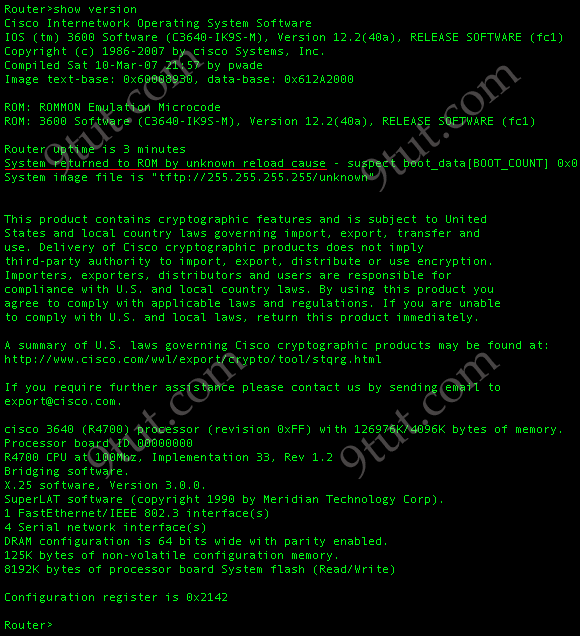
Question 3
When you are troubleshooting an ACL issue on a router, which command would you use to verify which interfaces are affected by the ACL?
A. show ip access-lists B. show access-lists C. show interface D. show ip interface E. list ip interface
Answer: D
CCNA Troubleshooting
Question 1
Refer to the exhibit:

Assuming that the entire network topology is shown, what is the operational status of the interfaces of R2 as indicated by the command output shown?
A. One interface has a problem. B. Two interfaces have problems. C. The interfaces are functioning correctly. D. The operational status of the interfaces cannot be determined from the output shown.
Answer: C
Explanation
From the output we see the Serial0/0 of RouterA is in “status up/protocol down” state which indicates a Layer 2 problem so the problem can be:
+ Keepalives mismatch + Encapsulation mismatch + Clocking problem
Question 2
Refer to the exhibit:
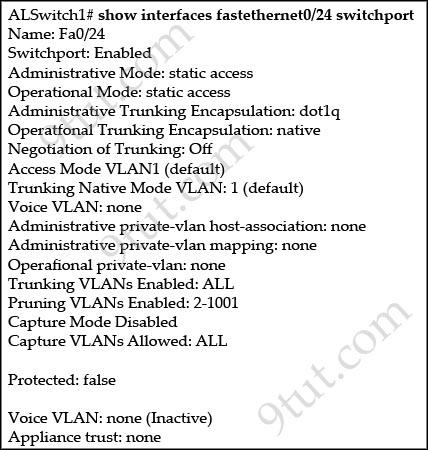
Switch port FastEthernet 0/24 on AlSwitch1 will be used to create an IEEE 802.1Q-complaint trunk to another switch. Based on the output shown, What is the reason the trunk does not form, even thought the proper cabling has been attached?
A. VLANs have not been created yet. B. An IP address must be configured for the port. C. The port is currently configured for access mode. D. The correct encapsulation type has not been configured. E. The no shutdown command has not been entered for the port.
Answer: C
Explanation
The “Operational Mode” is “static access” so this port is currently in access mode.
Question 3
Refer to the exhibit:

The Bigtime router is unable to authenticate to the Littletime router. What is the cause of the problem?
A. The usernames are incorrectly configured on the two routers. B. The passwords do not match on the two routers. C. CHAP authentication cannot be used on a serial interface. D. The routers cannot be connected from interface S0/0 to interface S0/0. E. With CHAP authentication, one router must authenticate to another router. The routers cannot be configured to authenticate to each other.
Answer: B
Explanation
Both routers must use the same password for CHAP to authentication.
Question 4
Refer to the exhibit. Hosts in network 192.168.2.0 are unable to reach hosts in network 192.168.3.0. Based on the output from RouterA, what are two possible reasons for the failure? (Choose two)
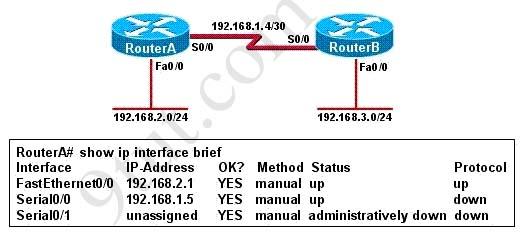
A. The cable that is connected to S0/0 on RouterA is faulty. B. Interface S0/0 on RouterB is administratively down. C. Interface S0/0 on RouterA is configured with an incorrect subnet mask. D. The IP address that is configured on S0/0 of RouterB is not in the correct subnet. E. Interface S0/0 on RouterA is not receiving a clock signal from the CSU/DSU. F. The encapsulation that is configured on S0/0 of RouterB does not match the encapsulation that is configured on S0/0 of RouterA.
Answer: E F
Question 5
Which command can be used from a PC to verify the connectivity between hosts that connect through a switch in the same LAN?
A. pingaddress B. tracertaddress C. tracerouteaddress D. arpaddress
Answer: A
Question 6
Two routers named Atlanta and Brevard are connected by their serial interfaces as illustrated, but there is no connectivity between them. The Atlanta router is known to have a correct configuration. Given the partial configurations, identify the problem on the Brevard router that is causing the lack of connectivity.
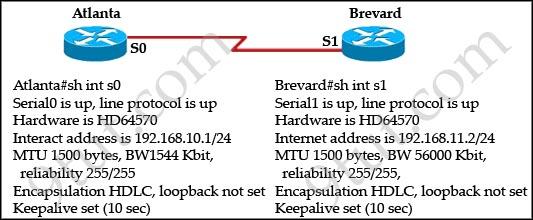
A. transmission unit size too large B. no loopback set C. an incorrect subnet mask D. incompatible encapsulation at each end E. an incorrect IP address F. incompatible bandwidth between routers
Answer: E
Question 7
Refer to the exhibit. HostA cannot ping HostB. Assuming routing is properly configured, what could be the cause of this problem?
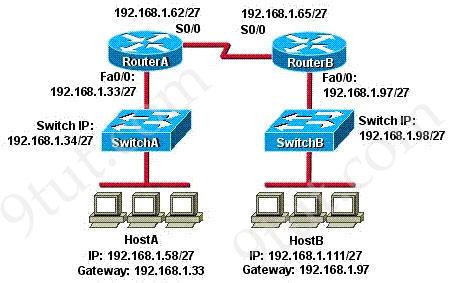
A. HostA is not on the same subnet as its default gateway. B. The address of SwitchA is a subnet address. C. The Fa0/0 interface on RouterA is on a subnet that can’t be used. D. The serial interfaces of the routers are not on the same subnet. E. The Fa0/0 interface on RouterB is using a broadcast address.
Answer: D
Explanation
Now let’s find out the range of the networks on serial link:
For the network 192.168.1.62/27:
Increment: 32 Network address: 192.168.1.32 Broadcast address: 192.168.1.63
For the network 192.168.1.65/27:
Increment: 32 Network address: 192.168.1.64 Broadcast address: 192.168.1.95
-> These two IP addresses don’t belong to the same network and they can’t see each other -> D is the correct answer.
Question 8
|
Router# show interface s0/0 Serial 0/0/0 is administratively down, line protocol is down |
What is the reason that the interface status is “administratively down, line protocol down”?
A. There is no encapsulation type configured. B. There is a mismatch in encapsulation types. C. The interface is not receiving any keepalives. D. The interface has been configured with the shutdown command. E. The interface needs to be configured as a DTE device. F. The wrong type of cable is connected to the interface.
Answer: D
Question 9
Refer to the exhibit. A network administrator configures a new router and enters the copy startup-config running-config on the router. The network administrator powers down the router and sets it up at a remote location. When the router starts, it enter the system configuration dialog as shown. What is the cause of the problem?
|
— System Configuration Dialog — Would you like to enter the initial configuration dialog? [yes/no]: % Please answer yes’ or ‘no’. Would you like to enter the initial configuration dialog? [yes/ho]: n Would you like to terminate autoinstall? [yes]: Press RETURN to get started! |
A. The network administrator failed to save the configuration. B. The configuration register is set to 0×2100. C. The boot system flash command is missing from the configuration. D. The configuration register is set to 0×2102. E. The router is configured with the boot system startup command.
Answer: A
Explanation
The “System Configuration Dialog” appears only when no startup configuration file is found. The network administrator has made a mistake because the command “copy startup-config running-config” will copy the startup config (which is empty) over the running config (which is configured by the administrator). So everything configured was deleted.
Note: We can tell the router to ignore the start-up configuration on the next reload by setting the register to 0×2142. This will make the “System Configuration Dialog” appear at the next reload.
CCNA IPv6
Question 1
Which IPv6 address is valid?
A. 2031:0:130F::9C0:876A:130B B. 2001:0DB8:0000:130F:0000:0000:08GC:140B C. 2001:0DB8:0:130H::87C:140B D. 2031::130F::9C0:876A:130B
Answer: A
Explanation
Answer B is not correct because it has a letter “G”.
Answer C is not correct because it has a letter “H”.
Answer D is not correct because it has two “::”.
Question 2
Which IPv6 address is the equivalent of the IPv4 interface loopback address 127.0.0.1?
A. ::1 B. :: C. 2000::/3 D. 0::/10
Answer: A
Question 3
How many bits are contained in each field of an IPv6 address?
A. 24 B. 4 C. 8 D. 16
Answer: D
Question 4
Which IPv6 address is the all-router multicast group?
A. FF02::1 B. FF02::2 C. FF02::3 D. FF02::4
Answer: B
Question 5
Which three are characteristics of an IPv6 anycast address? (Choose three)
A. one-to-many communication model B. one-to-nearest communication model C. any-to-many communication model D. a unique IPv6 address for each device in the group E. the same address for multiple devices in the group F. delivery of packets to the group interface that is closest to the sending device
Answer: B E F
Question 6
Which two are features of IPv6? (Choose two)
A. multicast B. broadcast C. allcast D. podcast E. anycast
Answer: A E
Explanation
Anycast IPv6 addresses are 128-bit identifiers for interfaces and sets of interfaces. A packet sent to an anycast address is delivered to one of the interfaces identified by that address (the “nearest” one, according to the routing protocols’ measure of distance)
Question 7
Which three approaches can be used while migrating from an IPv4 addressing scheme to an IPv6 scheme? (Choose three)
A. static mapping of IPv4 address to IPv6 addresses B. configuring IPv4 tunnels between IPv6 islands C. use DHCPv6 to map IPv4 addresses to IPv6 addresses D. use proxying and translation (NAT-PT) to translate IPv6 packets into IPv4 packets E. configure IPv6 directly F. enable dual-stack routing
Answer: B D F
Question 8
Which of these represents an IPv6 link-local address?
A. FE08::280e:611:a:f14f.3d69 B. FE81::280f.512b:e14f:3d69 C. FE80::380e:611a:e14f:3d69 D. FEFE:0345:5f1b::e14d:3d69
Answer: C
Explanation
The range of IPv6 link-local address (similar to the Windows auto-configuration IP address of 169.254.x.x.) is FE80::/10. For more information about IPv6, please read my IPv6 tutorial.
Question 9
Which command enables IPv6 forwarding on a cisco router?
A. IPv6 host B. IPv6 unicast-routing C. IPv6 local D. IPv6 neighbor
Answer: B
Explanation
An example of configuring RIPng (similar to RIPv2 but is used for IPv6) is shown below:
Router(config)#ipv6 unicast-routing (Enables the forwarding of IPv6 unicast datagrams globally on the router) Router(config)#interface fa0/0 Router(config-if)#ipv6 rip 9tut enable (9tut is the process name of this RIPng)
Question 10
Which two statements describe characteristics of IPv6 unicast addressing? (Choose two)
A. Global addresses start with 2000::/3 B. Link-local addresses start with FE00:/12 C. Link-local addresses start with FF00::/10 D. There is only one loopback address and it is ::1 E. If a global address is assigned to an interface, then that is the only allowable address for the interface.
Answer: A D
Explanation
Below is the list of common kinds of IPv6 addresses:
|
Loopback address |
::1 |
|
Link-local address |
FE80::/10 |
|
Site-local address |
FEC0::/10 |
|
Global address |
2000::/3 |
|
Multicast address |
FF00::/8 |
From the above table, we learn that A and D are correct while B and C are incorrect. Notice that the IPv6 unicast loopback address is equivalent to the IPv4 loopback address, 127.0.0.1. The IPv6 loopback address is 0:0:0:0:0:0:0:1, or ::1.
E is not correct because of anycast addresses which are indistinguishable from normal unicast addresses. You can think of anycast addresses like this: “send it to nearest one which have this address”. An anycast address can be assigned to many interfaces and the first interface receives the packet destined for this anycast address will proceed the packet. A benefit of anycast addressing is the capability to share load to multiple hosts. An example of this benefit is if you are a Television provider with multiple servers and you want your users to use the nearest server to them then you can use anycast addressing for your servers. When the user initiates a connection to the anycast address, the packet will be routed to the nearest server (the user does not have to specify which server they want to use).
CCNA IPv6 questions 2
Question 1
What are three features of the IPv6 protocol? (Choose three) A. optional IPsec B. autoconfiguration C. no broadcasts D. complicated header E. plug-and-play F. checksums
Answer: B C E
Question 2
Which two of these statements are true of IPv6 address representation? (Choose two)
A. The first 64 bits represent the dynamically created interface ID. B. A single interface may be assigned multiple IPV6 addresses of any type. C. Every IPV6 interface contains at least one loopback address. D. Leading zeros in an IPV6 16 bit hexadecimal field are mandatory.
Answer: B C
Explanation
Leading zeros in IPv6 are optional do that 05C7 equals 5C7 and 0000 equals 0 -> D is not correct.
Question 3
Which option is a valid IPv6 address?
A. 2001:0000:130F::099a::12a B. 2002:7654:A1AD:61:81AF:CCC1 C. FEC0:ABCD:WXYZ:0067::2A4 D. 2004:1:25A4:886F::1
Answer: D
Question 4
What is the alternative notation for the IPV6 address B514:82C3:0000:0000:0029:EC7A:0000:EC72?
A. B514:82C3:0029::EC7A:0000:EC72 B. B514:82C3:0029:EC7A:EC72 C. B514:82C3::0029:EC7A:0:EC72 D. B514:82C3::0029:EC7A:EC72
Answer: C
Question 5
Which switch would STP choose to become the root bridge in the selection process?
A. 32768: 11-22-33-44-55-66 B. 32768: 22-33-44-55-66-77 C. 32769: 11-22-33-44-55-65 D. 32769: 22-33-44-55-66-78
Answer: A
Question 6
Which command can you use to manually assign a static IPV6 address to a router interface?
A. ipv6 address PREFIX_1::1/64 B. ipv6 autoconfig 2001:db8:2222:7272::72/64 C. ipv6 autoconfig D. ipv6 address 2001:db8:2222:7272::72/64
Answer: D
Explanation
An example of configuring IPv6 on an interface is shown below:
Router(config)# interface fastethernet 0/0 Router(config-if)# ipv6 address 3000::1/64
Question 7
What is known as “one-to-nearest” addressing in IPv6?
A. global unicast B. anycast C. multicast D. unspecified address
Answer: B
Question 8
The network administrator has been asked to give reasons for moving from IPv4 to IPv6. What are two valid reasons for adopting IPv6 over IPv4? (Choose two)
A. telnet access does not require a password B. nat C. no broadcast D. change of destination address in the IPv6 header E. change of source address in the IPv6 header F. autoconfiguration
Answer: C F
Explanation
With IPv6, devices can build a link-local address automatically. But notice this address is only used for communications within the local subnetwork, routers do not forward these addresses.
CCNA Drag and Drop 1
Here you will find answers to drag and drop Questions – Part 1
Question 1:
A dental firm is redesigning the network that connects its three locations. The administrator gave the networking team 192.168.164.0 to use for addressing the entire netwok. After subnetting the address, the team is ready to assign the addresses. The administrator plans to configure ip subnet-zero and use RIP v2 as the routing protocol. As a member of the networking team, you must address the network and at the same time conserver unused addresses for future growth. With those goals in mind, drag the host addresses on the left to the correct router interface. Once of the routers is partially configured. Move your mouse over a router to view its configuration. Not all of the host addresses on the left are necessary.

Answer:

Explanation:
In short, we should start calculating from the biggest network (with 16 hosts) to the smallest one using the formula 2n – 2 (n is the number of bits we need to borrow).Therefore:
16 hosts < 25 – 2 (we need to borrow 5 bits -> /27)
11 hosts < 24 – 2 (borrow 4 bits -> /28)
5 hosts < 23 – 2 (borrow 3 bits -> /29)
From the available ip addresses, we see that each of them has only one suitable solution (they are 192.168.164.149/27,192.168.164.166/28 and 192.168.164.178/29)
The smallest network is the Floss S0/0 which only requires 2 hosts = 22 – 2 (need to borrow 2 bits ->/30). There are 2 suitable answers: 192.168.164.189/30 and 192.168.164.188/30 but notice that 192.168.164.188/30 is the network address so we can not use it (because 188 = 4 * 47) -> we have to choose 192.168.164.189 as the correct solution.
In fact, it is not the formal way to solve a VLSM question so I recommend you to review your CCNA book if you haven’t grasped it well yet.
Question 2:
In order to complete a basic switch configuration, drag each switch IOS command on the left to its purpose on the right
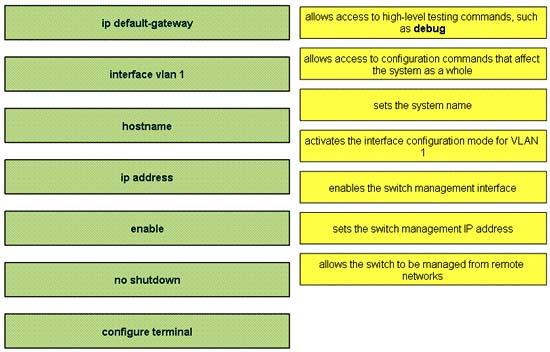
Answer:
1) enable
2) configure terminal
3) hostname
4) Interface vlan 1
5) no shutdown
6) ip address
7) ip default-gateway
Question 3:
The Missouri branch office router is connected through its s0 interface to the Alabama Headquarters router s1 interface. The Alabama router has two LANs. Missouri users obtain Internet access through the Headquarters router. The network interfaces in the topology are addressed as follows: Missouri: e0 – 192.168.35.17/28; s0 – 192.168.35.33/28; Alabama: e0 – 192.168.35.49/28; e1 – 192.168.35.65/28; s1 – 192.168.35.34/28. The accounting server has the address of 192.168.35.66/28. Match the access list conditions on the left with the goals on the right. (Not all options on the left are used.)
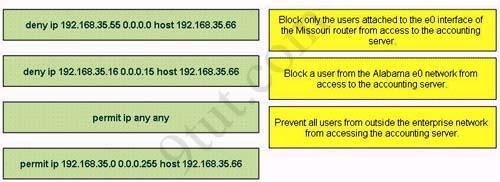
Answer:
1) deny ip 192.168.35.16 0.0.0.15 host 192.168.35.66
2) deny ip 192.168.35.55 0.0.0.0 host 192.168.35.66
3) permit ip 192.168.35.0 0.0.0.255 host 192.168.35.66
Explanation:
1) The wildcard mask of the command “deny ip 192.168.35.16 0.0.0.15 host 192.16.35.66″ is 0.0.0.15, which is equal to network mask of 255.255.255.240 = /28. So the access list will deny all traffic from network 192.168.35.16/28 from accessing host 192.16.35.66, which is the IP address of accounting server.
2) The command “deny ip 192.168.35.55 0.0.0.0 host 192.168.35.66″ will deny host 192.168.35.55, which is a user and belongs to interface e0 of Alabama router (192.168.35.49/28) from accessing accounting server.
3) Because there is an implicit “deny all” command at the end of each access list so the command “permit ip 192.168.35.0 0.0.0.255 host 192.168.35.66″ will only let network 192.168.35.0/24 access accounting server whilst prevent traffic from other networks.
Question 4:
A host with the address of 192.168.125.34/27 needs to be denied access to all hosts outside its own subnet. To accomplish this, complete the command in brackets, [access-list 100 deny protocol address mask any], by dragging the appropriate options on the left to their correct placeholders on the right.
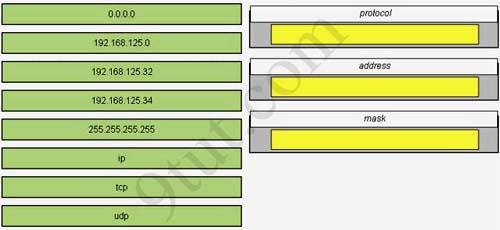
Answer:
1) ip
2) 192.168.125.34
3) 0.0.0.0
Full command: access-list 100 deny ip 192.168.125.34 0.0.0.0
Question 5:
Drag and drop the network user application to the appropriate description of its primary use (not all options are used)
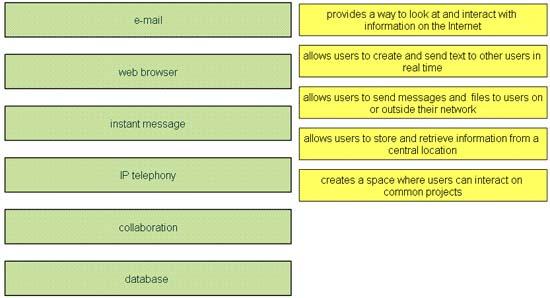
Answer:
1) web browser
2) instant message
3) e-mail
4) database
5) collaboration
Question 6:
This topology contains 3 routers and 1 switch. Complete the topology.
|
Drag the appropriate device icons to the labeled Device
Drag the appropriate connections to the locations labeled Connections. Drag the appropriate IP addresses to the locations labeled IP address |
(Hint: use the given host addresses and Main router information)
To remove a device or connection, drag it away from the topology.
Use information gathered from the Main router to complete the configuration of any additional routers. No passwords are required to access the Main router . The config terminal command has been disabled for the HQ router. The router does not require any configuration.
Configure each additional router with the following
|
Configure the interfaces with the correct IP address and enable the interfaces.
Set the password to allow console access to consolepw Set the password to allow telnet access to telnetpw Set the password to allow privilege mode access to privpw |
Note: Because routes are not being added to the configurations, you will not be able to ping through the internetwork.
All devices have cable autosensing capabilities disabled.
All hosts are PC’s
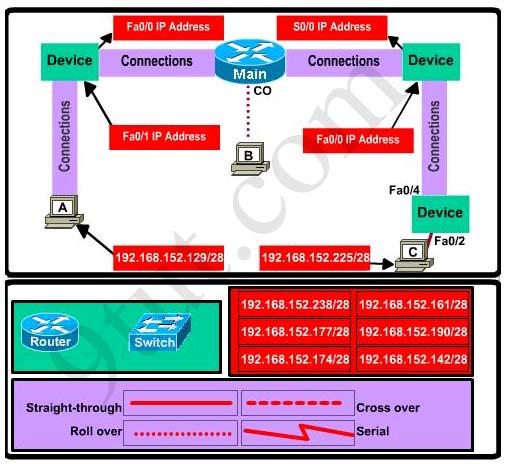
Answer:
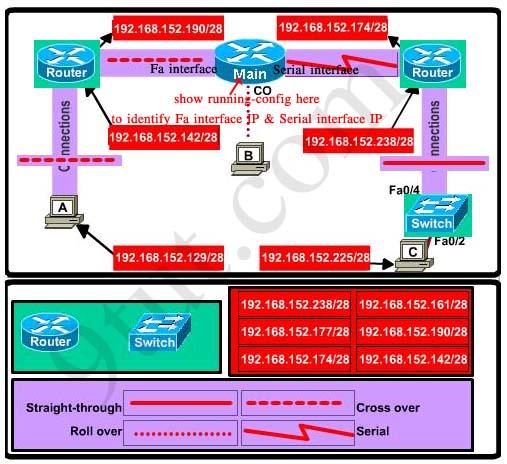
CCNA Drag and Drop 2
Here you will find answers to CCNA Drag and Drop Questions – Part 2
Question 1
The left describes OSI layers, while the right provides some terms. Drag the items on the right to the proper locations.
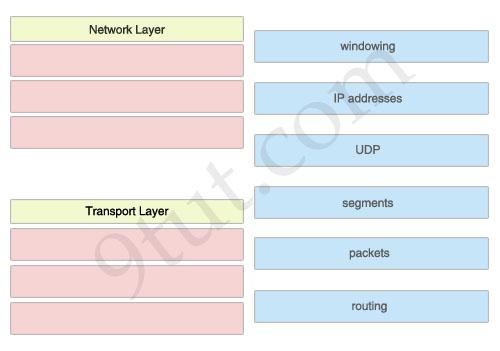
Answer:
Network Layer:
1) IP addresses 2) packets 3) routing
Transport Layer:
1) windowing 2) UDP 3) segments
Question 2
The above describes some categories, while the below provides their corresponding router output lines. Drag the above items to the proper locations.
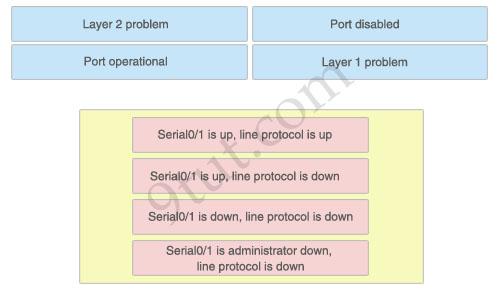
Answer:
1) Port operational: Serial0/1 is up, line protocol is up 2) Layer 2 problem: Serial0/1 is up, line protocol is down 3) Layer 1 problem: Serial0/1 is down, line protocol is down 4) Port disabled: Serial0/1 is administrator down, line protocol is down
Explanation:
A simple way to find out which layer is having problem is to remember this rule: “the first statement is for Layer 1, the last statement is for Layer 2 and if Layer 1 is down then surely Layer 2 will be down too”, so you have to check Layer 1 before checking Layer 2. For example, from the output “Serial0/1 is up, line protocol is down” we know that it is a layer 2 problem because the first statement (Serial0/1 is up) is good while the last statement (line protocol is down) is bad. For the statement “Serial0/1 is down, line protocol is down”, both layers are down so the problem belongs to Layer 1.
There is only one special case with the statement “…. is administrator down, line protocol is down”. In this case, we know that the port is currently disabled and shut down by the administrators.
Question 3
A user is unable to connect to the Internet. Based on the layered approach to troubleshooting and beginning with the lowest layer. Follow the guide and drag the contents to relevant modules.

Answer:
1) Verify Ethernet cable connection: Step 1 2) Verify NIC operation: Step 2 3) Verify IP configuration: Step 3 4) Verify URL: Step 4
Explanation:
The question asks us to “begin with the lowest layer” so we have to begin with Layer 1: verify physical connection; in this case an Ethernet cable connection. For your information, “verify Ethernet cable connection” means that we check if the type of connection (crossover, straight-through, rollover…) is correct, the RJ45 headers are plugged in, the signal on the cable is acceptable…
Next we “verify NIC operation”. We do this by simply making a ping to the loopback interface 127.0.0.1. If it works then the NIC card (layer 1,2) and TCP/IP stack (layer 3) are working properly.
Verify IP configuration belongs to layer 3. For example, checking if the IP can be assignable for host, the PC’s IP is in the same network with the gateway…
Verifying the URL by typing in your browser some popular websites like google.com, microsoft.com to assure that the far end server is not down (it sometimes make we think we can’t access to the Internet). We are using a URL so this step belongs to layer 7 of the OSI model.
Question 4
The left describes the types of cables, while the right describes the purposes of the cables. Drag the items on the left to the proper locations. (Not all items can be used).

Answer:
1) straight-through: switch access port to router 2) crossover: switch to switch 3) rollover: PC COM port to switch
Explanation:
To remember which type of cable you should use, follow these tips:
- To connect two serial interfaces of 2 routers we use serial cable – To specify when we use crossover cable or straight-through cable, we should remember: Group 1: Router, Host, Server Group 2: Hub, Switch One device in group 1 + One device in group 2: use straight-through cable Two devices in the same group: use crossover cable
For example: we use straight-through cable to connect switch to router, switch to host, hub to host, hub to server… and we use crossover cable to connect switch to switch, switch to hub, router to router, host to host… )
Question 5
The left describes the types of switch ports, while the right describes the features. Drag the options on the right to the proper locations.
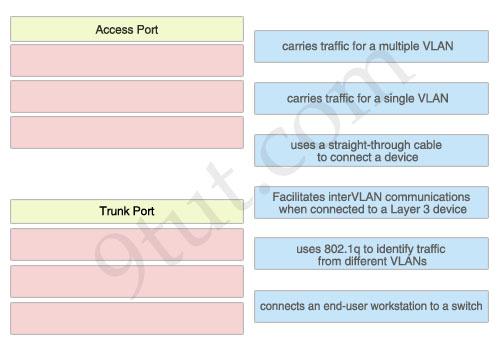
Answer:
Access Port:
- Carries traffic for a single VLAN – Uses a straight-through cable to connect a device – Connects an end-user workstation to a switch
Trunk Port:
- Carries traffic for a multiple VLAN – Uses 802.1q to identify traffic from different VLANs – Facilitates interVLAN communications when connected to a Layer 3 device
Question 6
The above describes the Spanning-Tree Protocol port states, while the below describes their functions. Drag the above items to the proper locations.
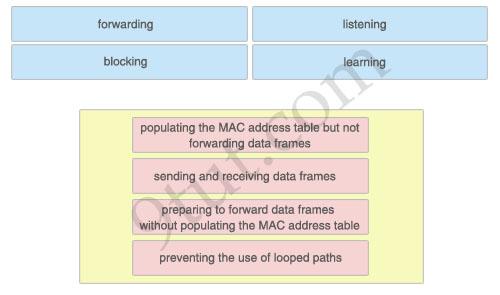
Answer:
- Learning: populating the MAC address table but not forwarding data frames – Forwarding: sending and receiving data frames – Listening: preparing to forward data frames without populating the MAC address table – Blocking: preventing the use of looped paths
CCNA Drag and Drop 3
Here you will find answers to CCNA Drag and Drop Questions – Part 3
Question 1
Drag the security features on the left to the specific security risks they help protect against on the right. (Not all options are used)
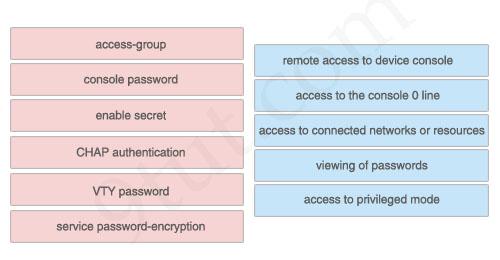
Answer:
1) VTY password: remote access to device console 2) console password: access to the console 0 line 3) access-group: access to connected networks or resources 4) service password-encryption: viewing of passwords 5) enable secret: access to privileged mode
The unselected left-box – CHAP – is used to verify the identity of the peer by means of a three-way handshake.
Question 2
Refer to the exhibit. PC-A is sending packets to the FTP server. Consider the packets as they leave RA interface Fa0/0 forwards RB. Drag the correct frame and packet address to their places in the table.
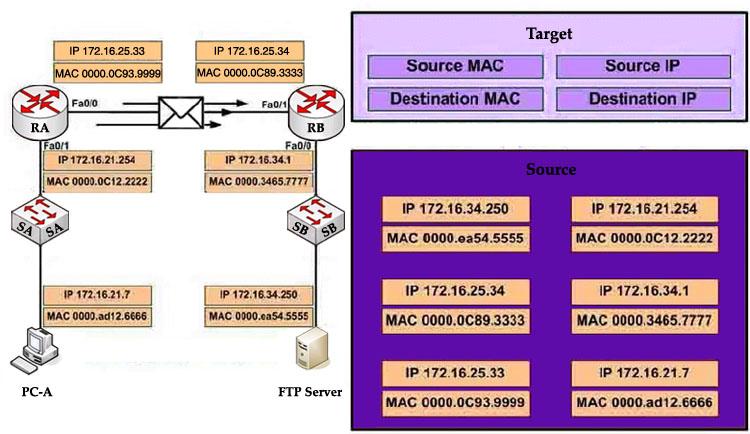
Answer:
Source MAC: 0000.0C93.9999 Destination MAC: 0000.0C89.3333 Source IP: 172.16.21.7 Destination IP: 172.16.34.250
Explanation
Remember these rules:
The IP addresses (of source and destination) of a packet never change during the transportation through the network. For example if PC-A wants to send a packet to PC-Z then the source and destination IP addresses of the packet will be the IP addresses of PC-A and PC-Z no matter how many devices they go through.
The MAC addresses, conversely, will change while passing the devices. The source MAC address is the address of the last sender and the destination MAC address is the address of the next device.
Question 3
As a network administrator, you are required to configure the network security policy. And the policy requires that only one host be permitted to attach dynamically to each switch interface. If that policy is violated, the interface should shut down. Which two commands must the network administrator configure on the 2950 Catalyst switch to meet this policy? Please choose appropriate commands and drag the items to the proper locations.

Answer:
Appropriate commands:
SW(config-if)# switchport port-security maximum 1 SW(config-if)# switchport port-security violation shutdown
Question 4
The left describes boot sequence, while the right describes the orders. Drag the items on the left to the proper locations.
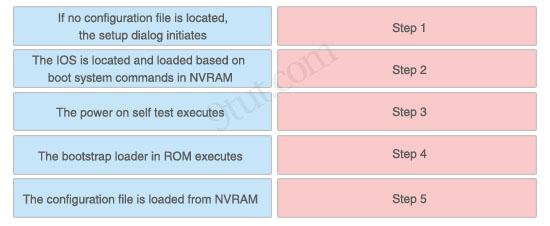
Answer:
1) Step 1: The power on self test executes. 2) Step 2: The bootstrap loader in ROM executes. 3) Step 3: The IOS is located and loaded based on boot system commands in NVRAM. 4) Step 4: The configuration file is loaded from NVRAM. 5) Step 5: If no configuration file is located, the setup dialog initiates.
Explanation
When a router boots up, it performs a series of steps, called the boot sequence, to test the hardware and load the necessary software. The boot sequence consists of the following steps:
1) Power on self test (POST): tests the hardware to verify that all components of the device are operational and present. 2) The bootstrap loader in ROM executes: The bootstrap loader is a program in ROM that is used to find where a valid Cisco IOS image is located. 3) If a valid Cisco IOS image is located, it is loaded. 4) IOS loads configuration file. Once the IOS image is loaded, it will search for a valid startup configuration in NVRAM. 5) If a valid startup configuration file cannot be found, the router will load the System Configuration Dialog (sometimes called setup mode). This mode allows you to perform the initial configuration of the router.
Question 5
Drag and Drop question. Drag the items to the proper locations.
Routing has been configured on the local router with these commands: Local(config)# ip route 0.0.0.0 0.0.0.0 192.168.1.1 Local(config)# ip route 10.1.0.0 255.255.255.0 192.168.2.2 Local(config)# ip route 10.1.0.0 255.255.0.0 192.168.3.3
Drag each destination IP address on the top to its correct next hop address at the bottom.
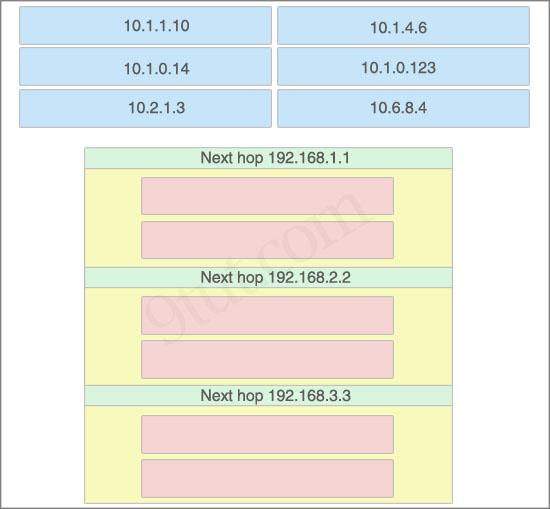
Answer:
Next hop 192.168.1.1: + 10.2.1.3 + 10.6.8.4
Next hop 192.168.2.2: + 10.1.0.14 + 10.1.0.123
Next hop 192.168.3.3: + 10.1.1.10 + 10.1.4.6
Explanation
If we have many entries matching for next hop ip address then the router will choose the one with most specific path to send the packet. This is called the “longest match” rule, the route with the most bits in the mask set to “1″ will be chosen to route packet.
For example, the destination IP address of 10.1.1.10 will match two “ip route” commands:
ip route 10.1.0.0 255.255.255.0 192.168.2.2 ip route 10.1.0.0 255.255.0.0 192.168.3.3
But the first command is more specific (10.1.0.0/24 is more specific than 10.1.0.0/16) so the packet will be routed to 192.168.2.2.
Question 6
If a Cisco router has learned about network 10.1.1.0 from multiple sources, the router will select and install only one entry into the routing table. Indicate the order of preference that the router will use by dragging the routes on the left to the order of preference category on the right.
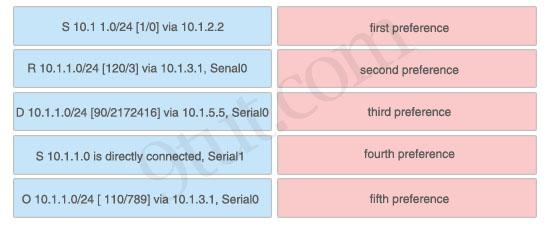
Answer:
1) First preference: S 10.1.1.0 is directly connected, Serial1 2) Second preference: S 10.1 1.0/24 [1/0] via 10.1.2.2 3) Third preference: D 10.1.1.0/24 [90/2172416] via 10.1.5.5, Serial0 4) Fourth preference: O 10.1.1.0/24 [ 110/789] via 10.1.3.1, Serial0 5) Fifth preference: R 10.1.1.0/24 [120/3] via 10.1.3.1, Senal0
Explanation
Administrative distance is the first criterion that a router uses to determine which routing protocol to use if two protocols provide route information for the same destination. It is a measure of the trustworthiness of the source of the routing information. The smaller the administrative distance value, the more reliable the protocol.
In this question, notice that the destination of all routes is 10.1.1.0/24 so we need to use Administrative distance of each routing protocol to specify the priority of each route. Below lists the Administrative Distance default values of popular routing protocols:
+ Directly connected: 0 + Static route: 1 + EIGRP (symbolize by “D”): 90 + OSPF (symbolize by “O”): 110 + RIP (symbolize by “R”): 120
CCNA Drag and Drop 4
Here you will find answers to CCNA Drag and Drop Questions – Part 4
Question 1
Drag the function on the left to the matching security appliance or application on the right. (Not all functions are used)
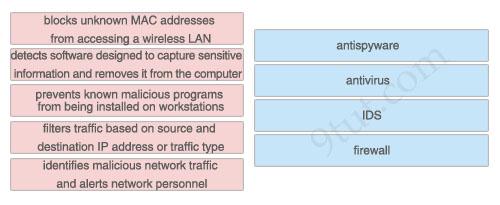
Answer:
1) antispyware: detects software designed to capture sensitive information and removes it from the computer 2) antivirus: prevents known malicious programs from being installed on workstations 3) IDS: identifies malicious network traffic and alerts network personnel 4) firewall: filters traffic based on source and destination IP address or traffic type
Question 2
Drag the Frame Relay acronym on the left to match its definition on the right. (Not all acronyms are used)
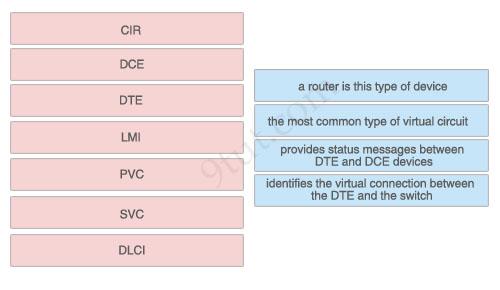
Answer:
1) a router is this type of device: DTE 2) the most common type of virtual circuit: PVC 3) provides status messages between DTE and DCE devices: LMI 4) identifies the virtual connection between the DTE and the switch: DLCI
Question 3
The left describes some types of connections while the right describes some types of cables. Drag the items on the left to the proper locations.
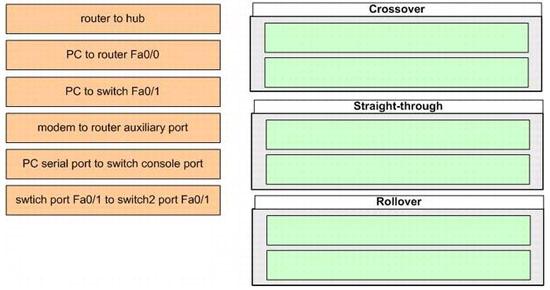
Answer:

Explanation:
To specify when we use crossover cable or straight-through cable, we should remember: Group 1: Router, Host(PC), Server Group 2: Hub, Switch One device in group 1 + One device in group 2: use straight-through cable Two devices in the same group: use crossover cable
For example: we use straight-through cable to connect switch to router, switch to host, hub to host, hub to server… and we use crossover cable to connect switch to switch, switch to hub, router to router, host to host… ).
+ We can connect a modem to router auxiliary port using a rollover cable. Recall that the purpose of the router’s auxiliary port is for connecting to a modem and most Cisco routers have a second port on the back called the auxiliary port. We can use this port in case of a far-away router goes down, the administrator can have someone in the area go to the router, plug in a modem and access to the router remotely (if using the console port, we have to go to the site to work with that router).
+ We can connect a PC serial port to a switch/router console port through the RJ-45 to DB-9 or RJ-45 to DB-25 adapter (at the PC end), depending on the computer.
Question 4
The above provides some descriptions, while the below provides some routing protocols. Drag the above items to the proper locations.
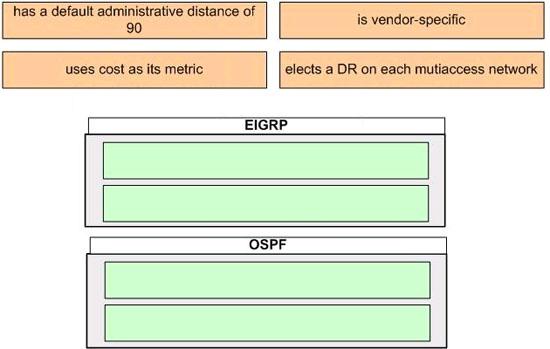
Answer:
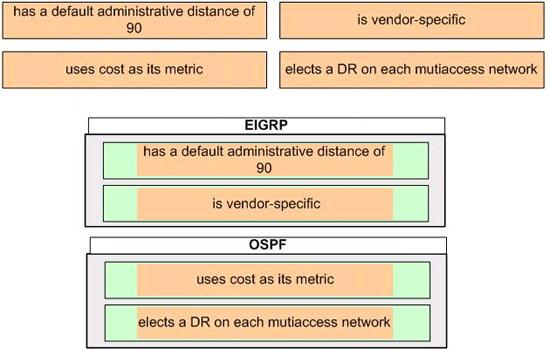
Explanation:
Enhanced Interior Gateway Routing Protocol (EIGRP) is a Cisco proprietary routing protocol, so it is vendor-specific. By default, EIGRP internal routes have an administrative distance value of 90.
OSPF uses cost as its metric. By default, the cost of an interface is calculated based on bandwidth with the formula cost= 10000 0000/bandwith (in bps). OSPF elects a DR on each broadcast and nonbroadcast multiaccess networks (like Ethernet and Frame Relay environments, respectively). It doesn’t elect a DR on point-to-point link (like a serial WAN).
Question 5
As a CCNA candidate, you are required to have a firm understanding of the OSI model. At which layers of the OSI model do Wide Area Networks operate in? Please drag the items to the proper locations.
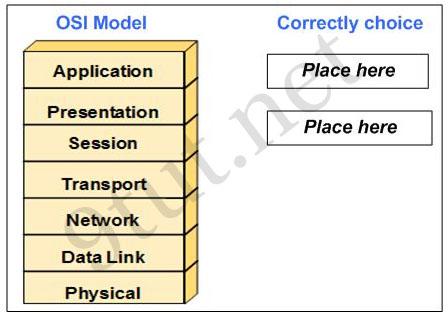
Answer:
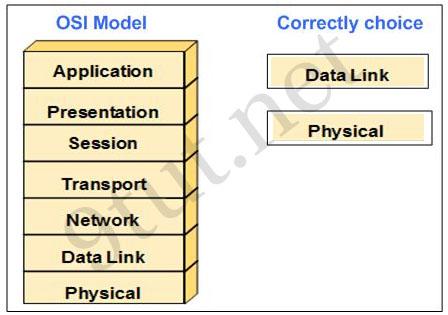
Explanation
WAN operates in the two lowest layers which are Data Link and Physical layers.
CCNA Drag and Drop 5
Here you will find answers to Drag and Drop Questions – Part 5
Question 1
Drag the Cisco default administrative distance to the appropriate routing protocol or route (Not all options are used)

Answer:
+ RIP: 120 + OSPF: 110 + static route referencing IP address of next hop: 1 + internal EIGRP route: 90 + directly connected network: 0
Question 2
Drag the term on the left to its definition on the right (not all options are used)

Answer:
+ poison reverse: A router learns from its neighbor that a route is down and the router sends an update back to the neighbor with an infinite metric to that route + LSA: The packets flooded when a topology change occurs, causing network routers to update their topological databases and recalculate routes + split horizon: This prevents sending information about a routeback out the same interface that originally learned about the route + holddown timer: For a given period, this causes the router to ignore any updates with poorer metrics to a lost network
Question 3
Drag the description on the left to the correct router mode on the right

Answer:
+ user EXEC mode: limited to basic monitoring commands + privileged EXEC mode: provide access to all other router commands + global configuration mode: commands that affect the entire system + specific configuration mode: commands that affect interfaces/processes only + setup mode: interactive configuration dialog
Question 4
Drag each definition on the left to the matching term on the right
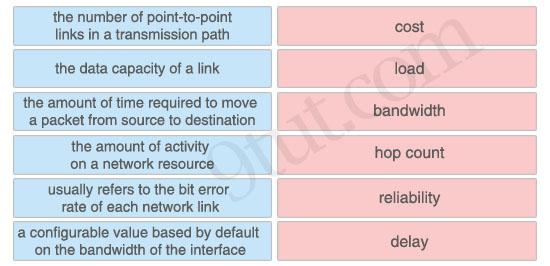
Answer:
+ cost: a configurable value based by default on the bandwidth of the interface + load: the amount of activity on a network resource + bandwidth: the data capacity of a link + hop count: the number of point-to-point links in a transmission path + reliability: usually refers to the bit error rate of each network link + delay: the amount of time required to move a packet from source to destination
Question 5
Refer to the exhibit. Complete the network diagram by dragging the correct device name or description to the correct location. Not all the names or descriptions will be used.

Answer:
From left to right:
Router, DTE, DCE, CSU/DSU Synchronous, Digital Line, WAN Service Provider Network.
Question 6
Drag each feature on the left to the appropriate routing protocol on the right.

Answer:
RIP version 1
+ sends frequent updates + less complex configuration + susceptible to routing loops + exchanges full routing table in updates
OSPF:
+ faster convergence + uses only event-triggered updates + same topology information held by all routers + requires more memory and processing power
Question 7
Drag item on left to match item on right

Answer:
+ Point to Point Advantage: Quality + Point to Point Disadvantage: Limited Flexibility + Circuit Switched Advantage: Cost + Circuit Switched Disadvantage: Low speed + Packet Switch Advantage: Efficient + Packet Switch Disadvantage: More Complex
Question 8
All hosts in the same subnet with 172.16.5.118/26 must be denied Telnet access to hosts outside the LAN (u need to just drag & drop) fiil out the command. To complete the bracketed command, [access-list list-number deny tcp 172.16.5.address 0.0.0.mask any eq port], drag each appropriate option on the left to its proper placeholder on the right. (Not all options are used)
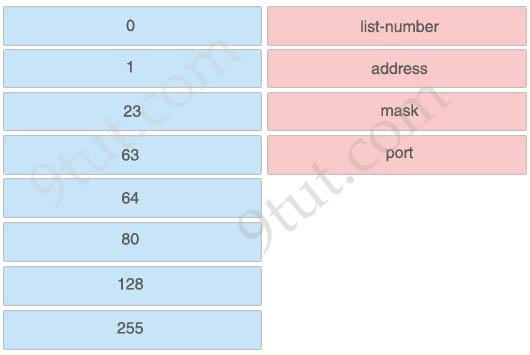
Answer:
+ list-number: 128 + address: 64 + mask: 63 + port: 23
